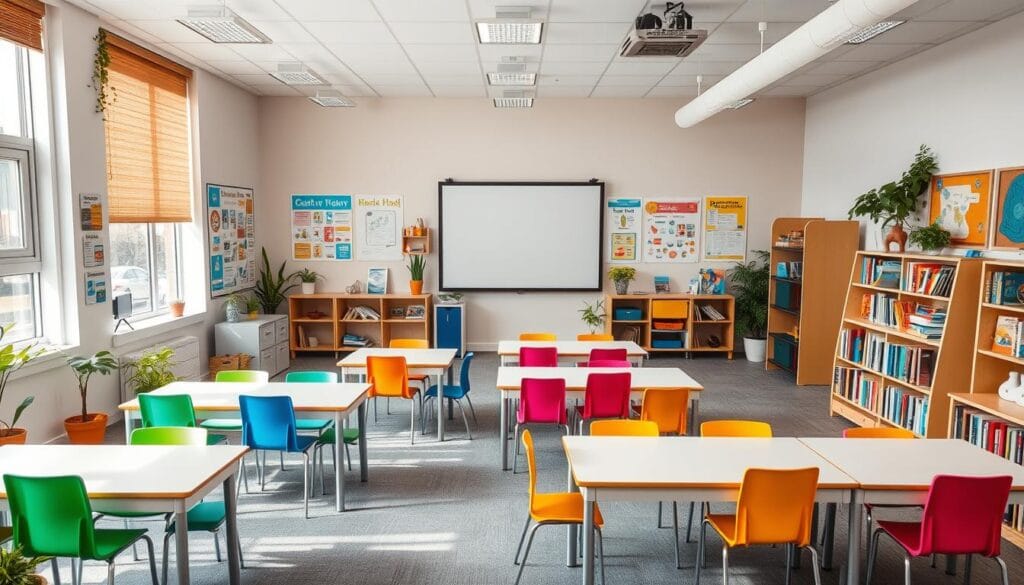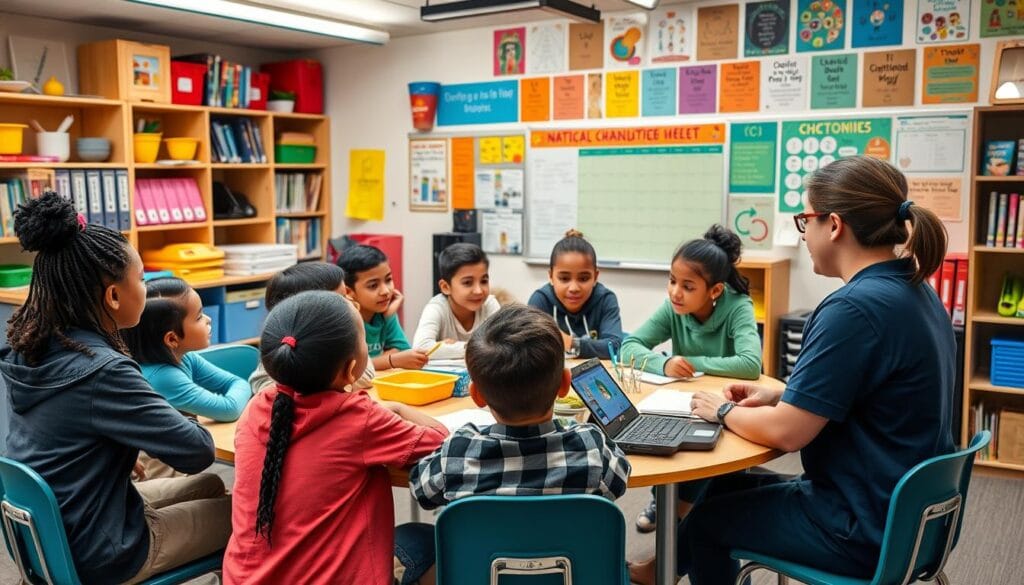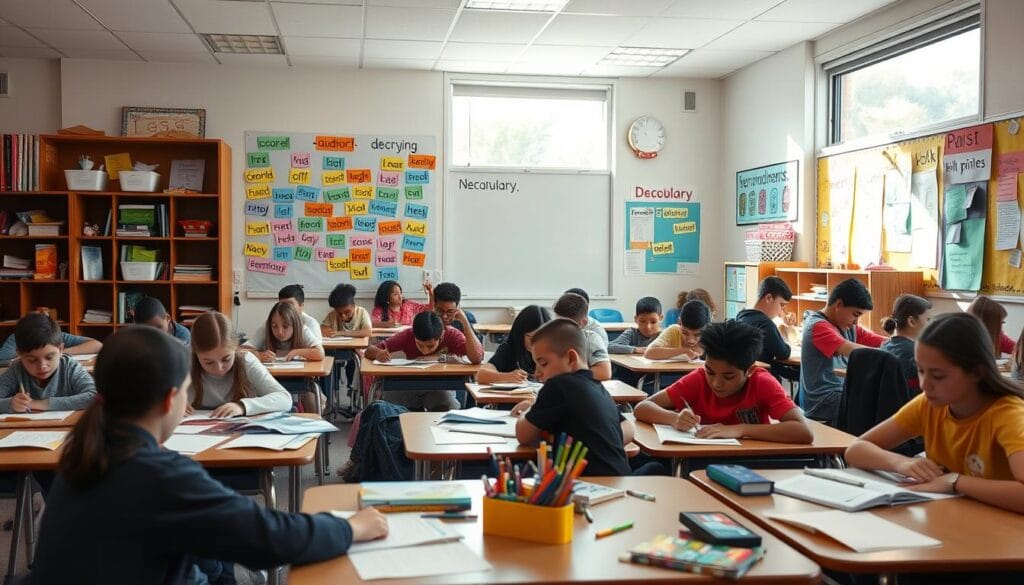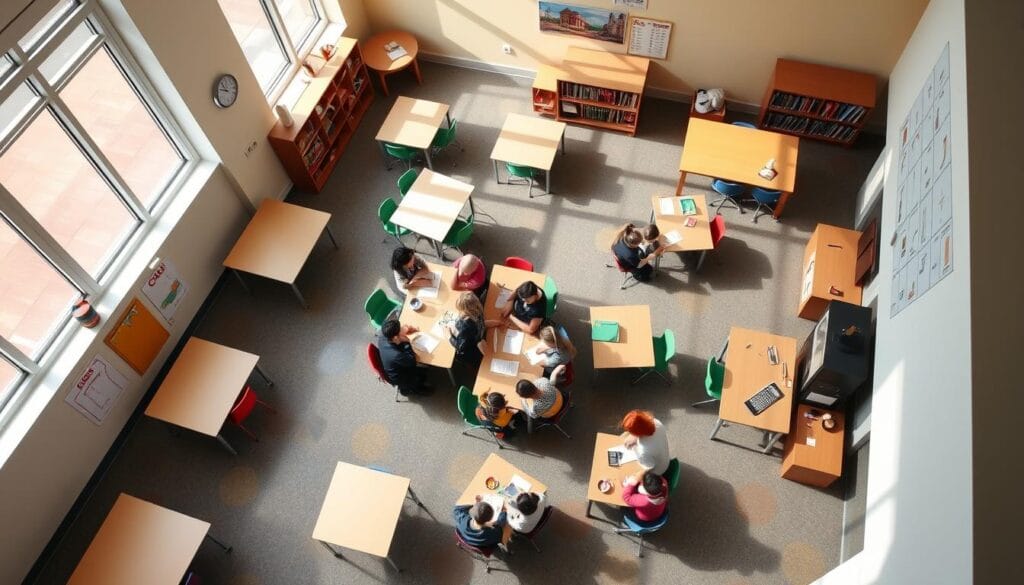Simple and Effective Tips for Creating a Classroom Seating Plan
Creating a good classroom seating plan is key to a better learning space. The way you arrange your classroom affects how students work together and learn. A well-thought-out seating plan can make your classroom more welcoming and productive.
In this article, we’ll share easy yet effective tips for making a seating plan that meets your students’ needs. You’ll learn about the importance of a good classroom layout and how to design a plan that works. You’ll discover how to turn your classroom into a lively and engaging place for learning.
فهرس المقالة
Understanding the Importance of Strategic Classroom Layout
The classroom layout is key in shaping the learning environment. It affects how students engage with their studies. By designing the seating and layout, teachers can make a space that boosts productivity and teamwork.
Impact on Student Learning and Engagement
A well-designed classroom layout can greatly impact student learning. Research shows that the setup of desks and furniture influences focus and participation. A thoughtful layout can lead to better attention, more discussions, and effective learning.
Benefits of Well-Organized Seating Arrangements
Strategic seating in the classroom layout brings many benefits. It improves visibility, letting students see the teacher and aids clearly. It also encourages teamwork, building a sense of community and improving social skills.
Creating an Inclusive Learning Environment
The classroom layout is vital for inclusivity. By considering students’ diverse needs, teachers can create a welcoming space. This includes flexible seating, enough space, and strategic student placement to boost participation.
“The physical arrangement of a classroom can either facilitate or impede learning. A well-designed layout can enhance student engagement, collaboration, and overall academic performance.”
| Aspect | Impact on Learning |
|---|---|
| Visibility | Improved ability to see the teacher and visual aids, resulting in better focus and understanding. |
| Collaboration | Seating arrangements that encourage group work can foster teamwork, communication, and problem-solving skills. |
| Inclusivity | Flexible and accessible seating options can create a more welcoming and inclusive learning environment for all students. |
Essential Factors to Consider Before Creating Your Classroom Seating Plan
Creating a good classroom seating plan is all about careful thought. As a teacher, you need to look at your classroom, your students, and what you want to teach. This way, you can make a seating plan that helps students learn and feel included.
Start by looking at your classroom. Think about its size, layout, and how many desks or tables you have. Also, consider any special features or things that might affect where students sit. This helps you use the space well.
Then, think about what makes each student unique. Look at their learning styles, how they get along with others, and if they need special help. This lets you place students where they can learn best.
Also, match your seating plan to how you teach and what you want students to learn. Think about if you like to lecture, have group talks, or work on projects. Arrange the seats to help you teach better and meet your goals.
| Factors to Consider | Importance |
|---|---|
| Classroom Size and Layout | Ensures optimal use of available space and minimizes distractions. |
| Student Needs and Characteristics | Allows for personalized learning experiences and promotes inclusivity. |
| Teaching Style and Learning Objectives | Aligns the seating arrangement with your instructional approach and desired outcomes. |
By thinking about these important points, you can make a seating plan that helps your students learn well and enjoy it.

Different Types of Desk Configurations for Optimal Learning
Choosing the right desk setup in a classroom can really help students learn better. Different desk arrangements can make the classroom more engaging and inclusive. This helps teachers meet their students’ needs and create a collaborative space.
Traditional Row Arrangement
The traditional row setup is common and easy to manage. It’s great for lectures and individual work. This setup helps keep things organized and focused.
Collaborative Group Clusters
Grouping desks into clusters encourages teamwork. This desk configuration boosts student interaction and active learning. It’s perfect for group projects and discussions.
U-Shaped Configuration
The U-shaped classroom layout has desks in a horseshoe shape. It makes the classroom more inclusive and engaging. This setup improves visibility and fosters a sense of community.
Flexible Seating Options
- Standing desks or high tables: Let students move and work actively.
- Bean bags or floor cushions: Create a cozy, informal seating chart for creativity and relaxation.
- Movable furniture: Makes it easy to change the desk configuration for different activities.
Exploring these desk configuration options helps teachers create a flexible and engaging classroom layout. This tailored approach enhances the learning experience for all students.
| Desk Configuration | Advantages | Ideal Situations |
|---|---|---|
| Traditional Row Arrangement | Structured, Lecture-Focused | Direct Instruction, Individual Work |
| Collaborative Group Clusters | Promotes Teamwork, Active Learning | Group Projects, Discussions |
| U-Shaped Configuration | Inclusive, Enhanced Visibility | Discussions, Community Building |
| Flexible Seating Options | Variety, Movement, Comfort | Creativity, Individualized Needs |
Student Characteristics That Influence Seating Assignment

Creating an effective classroom seating plan is key. It’s important to think about each student’s unique needs. This includes their learning styles and how they behave.
Some students do best in groups, while others like to work alone. Knowing this helps you arrange desks to help each student learn better.
Behavior is also important. Students who have trouble focusing or controlling impulses might do better near the teacher. This setup helps them stay on track and avoid distractions.
Students with special needs, like physical or emotional challenges, need special seating. This ensures they’re comfortable and can reach their educational goals.
Classroom social dynamics matter too. Placing students who get along well together can make the classroom a positive place. It encourages teamwork and learning together.
| Student Characteristic | Impact on Seating Assignment |
|---|---|
| Learning Styles | Collaborative vs. independent learning preferences |
| Behavior | Proximity to teacher, minimizing distractions |
| Special Needs | Accommodating physical, cognitive, or emotional requirements |
| Social Dynamics | Fostering positive interactions and collaboration |
By carefully thinking about these factors, you can make a seating plan that works for everyone. It supports individual learning and creates a welcoming classroom. This improves the learning experience for all students.
Classroom Seating Plan Best Practices and Implementation
Creating a good classroom seating plan is key for a lively and welcoming learning space. It involves making digital seating charts and changing the setup as needed. These steps are important for a well-organized classroom.
Creating Digital Seating Charts
Using digital tools to make your seating plan is easier and more flexible. Many online tools let you design and update your seating easily. They also help you see how your classroom will look.
Managing Transitions Between Arrangements
Changing your seating plan as the year goes on is important. It helps meet students’ and teachers’ changing needs. Having a clear plan for these changes helps keep the classroom running smoothly.
Documenting and Updating Seating Plans
Keeping detailed records of your seating plan is crucial. It helps you track changes and see what works best. This information is useful for making your classroom even better over time.
| Best Practices for Classroom Seating Plans | Benefits |
|---|---|
| Use digital tools for seating chart creation and management | Streamlines the process, allows for easy updates |
| Implement a clear plan for transitioning between seating arrangements | Ensures a smooth process with minimal disruptions |
| Maintain detailed documentation of your seating plan and any changes | Facilitates reflection and informed decision-making |
By following these best practices, you can make a seating plan that supports learning all year. It will help keep your classroom lively and focused on student success.
Addressing Common Challenges in Student Arrangement

Teachers work hard to make the best learning space for students. They face many challenges, like student arrangement and classroom layout. Issues like student behavior and different learning needs make it tough. But, with the right strategies, these problems can be solved.
One big issue is when students act out. Some seating setups might make it harder to stay focused. A well-made seating chart can help keep things in order. Placing students who might get distracted in quiet spots helps everyone learn better.
It’s also hard to meet the needs of all students. Some might need special seating, like standing desks. These options help everyone feel included in the classroom.
| Common Challenges | Practical Solutions |
|---|---|
| Disruptive Student Behavior | Strategically place students with behavioral tendencies, implement a structured seating chart |
| Diverse Student Needs | Offer flexible seating options, provide necessary accommodations |
| Transitions Between Seating Arrangements | Establish clear procedures, involve students in the process |
Changing the seating arrangements can also be tricky. Teachers need to make these changes smoothly. Clear steps and student involvement help make these changes easy.
By tackling these challenges head-on, teachers can make a better learning space. This space encourages everyone to learn and feel included.

Adapting Your Seating Chart for Different Teaching Styles
Creating a good classroom seating chart is not the same for everyone. Your classroom layout should match your teaching style. Whether you teach through lectures, discussions, or projects, the right seating can greatly improve learning.
Lecture-Based Setup
In lecture-heavy classrooms, rows of seats work best. They help students stay focused and avoid distractions. Adding swivel chairs can also help students move between the teacher and screens.
Discussion-Oriented Layout
For classrooms that focus on discussions, group seating is better. Clusters of desks or tables encourage students to talk and work together. This setup is great for sharing ideas and solving problems.
Project-Based Configuration
Project-based learning needs a flexible seating plan. Try a U-shaped or circular setup. It makes it easy for students to work together and move around.
Changing your seating can really help students learn better. By matching your seating to your teaching style, you can make a learning space that works for everyone.
| Teaching Style | Recommended Seating Configuration | Key Benefits |
|---|---|---|
| Lecture-Based | Traditional Rows | Maintains focus, minimizes distractions |
| Discussion-Oriented | Collaborative Clusters | Encourages engagement, idea-sharing |
| Project-Based | Flexible U-Shape or Circle | Supports hands-on, collaborative learning |
Maximizing Learning Space Through Strategic Design
Creating a functional and inspiring learning environment is key for student success. By carefully planning your classroom design, you can make the most of the space. Start by choosing furniture that encourages collaboration and movement.
Managing traffic flow is crucial for students to move freely and access resources. Place high-traffic areas, like the teacher’s desk and supply stations, wisely. This helps avoid disruptions and boosts productivity. Adding technology, like interactive whiteboards or mobile device charging stations, can also improve the learning space.
Your classroom design should match your teaching style and your students’ needs. Try out different setups, such as flexible seating or modular furniture, to find the best fit. By strategically designing your classroom, you can create a space that fosters creativity, collaboration, and academic success.
FAQ
What are the key factors to consider when creating a classroom seating plan?
When making a classroom seating plan, think about the classroom size and student needs. Also, consider your teaching style and what you want students to learn. Look at your students’ learning styles, behavior, and special needs to make sure everyone feels included.
What are the different types of desk configurations for optimal learning?
There are many desk setups to choose from. You can have rows, group clusters, U-shapes, or flexible seating. Each setup works best with different teaching methods and learning goals.
How can I address common challenges in student arrangement?
Dealing with student issues like behavior problems and conflicts can be tough. To solve these, set clear rules and use visual aids. Also, make sure your seating plan meets each student’s needs.
How can I adapt my seating chart for different teaching styles?
To fit different teaching styles, customize your seating charts. For lectures, rows work well. For discussions, group clusters are better. For projects, flexible seating helps.
How can I maximize learning space through strategic classroom design?
To make the most of your classroom, choose the right furniture and manage traffic. Add technology to make learning fun and engaging. This way, you create a space that supports all kinds of learners.






